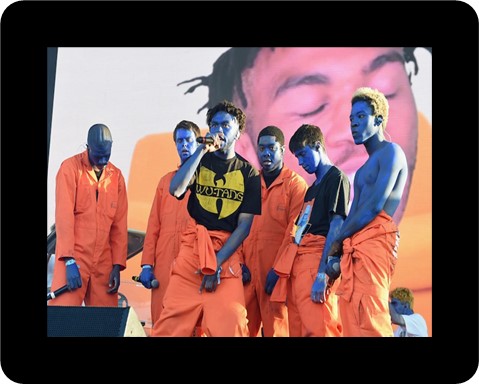Brockhampton: The All-American Boyband
by Maggie Sardino | Xchanges 16.2, Fall 2021

Introduction to Counterpublics
In her influential article “Rethinking the Public Sphere: A Contribution to the Critique of Actually Existing Democracy,” Nancy Fraser (1990) identifies what she refers to as subaltern counterpublics. She defines these groups as “discursive arenas where members of subordinated social groups invent and circulate counterdiscourses, which in turn permit them to formulate oppositional interpretations of their identities, interests, and needs” (p. 67). Fraser encourages her readers to understand late-twentieth century U.S. feminists as a prime example of a subaltern counterpublic.
Approximately a decade after Fraser’s defining article, Michael Warner (2002) challenged her conceptualization of counterpublics. Warner questions whether Fraser is really discussing counterpublics or simply subpublics. He writes, “Fraser here names an important phenomenon. But what makes such public ‘counter’ or ‘oppositional’? Is its oppositional character a function of its content alone—that is, its claim to be oppositional? In that case, we might simply call it a subpublic” (2002, p. 85). Warner argues that counterpublics are more than groups who present oppositional claims or offer reform programs. Counterpublics present a deeper level of opposition; they challenge the dominant life worlds within which claims function. Warner (2002) writes:
A counterpublic maintains at some level, conscious or not, an awareness of its subordinate status. The cultural horizon against which it marks itself off is not just a general or wider public, but a dominant one. And the conflict extends not just to ideas or policy questions, but to the speech genres and modes of address that constitute the public and to the hierarchy among media. (p. 86)
In Warner’s conceptualization of counterpublics, two important attributes emerge. First, for a collective to be considered a counterpublic, it must be oppositional to both the claims of dominant publics and from the cultural horizons within which those publics operate. Secondly, counterpublics must also function outside of the traditional genres and modes of address used by dominant publics. With these key elements of counterpublics in mind, I propose that the Hip-Hop collective Brockhampton functions as a counterpublic to traditional boybands. Brockhampton presents a challenge to the life worlds boybands embody, most centrally their positioning of white heteronormativity as the standard for perfection. Furthermore, Brockhampton uses non-traditional modes of communication that break away from the hierarchy of mainstream media. A prime example of this is their use of spectacle in music videos and song lyrics.
Moving beyond Brockhampton’s role as a counterpublic, I also examine the ethical obligations counterpublics have to address how they may embody and perpetuate the life worlds they actively challenge. Drawing upon Gwendolyn Pough’s (2004) discussion of the contradictory positions Hip-Hop artists often occupy, I argue that even as admitting and addressing contradiction is especially risky for counterpublics, it serves their best interest in the end.
 Download PDF
Download PDF